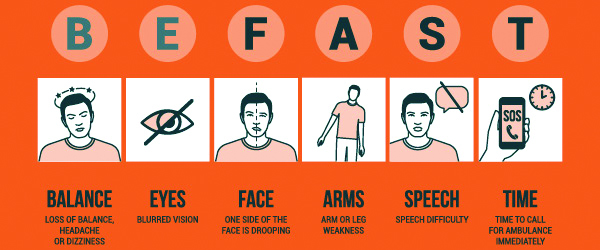A stroke can happen to anyone. Unfortunately, many still believe that they are only susceptible to it as they grow older. Of late, the number of stroke cases in Malaysia have been on the rise, which is an alarming sign for us all. Although the majority of those cases were found to be men over the age of 60, there is still a portion of those below that age who have gotten a stroke due to hereditary reasons.
Before all else, let’s find out what actually is a stroke, and why should you be aware of it?
A stroke is a serious medical condition which occurs when there is a lack of blood supply to parts of the brain due to blood clots, preventing the brain from getting oxygen and nutrients. Awareness of strokes is important, because identifying the symptoms and getting to a hospital as soon as possible can save lives.
Symptoms to be aware of
By learning the BE FAST warning signs, you could save a life:
- Balance – loss of balance, headache or dizziness
- Eyes – blurred vision
- Face – facial drooping on one side
- Arms – arm weakness
- Speech – speech difficulty
- Time – time to call for an ambulance
Here’s what you should do:
If any of these symptoms are prevalent, it is best to call for an ambulance for immediate medical attention. While waiting for the ambulance to arrive, make sure the stroke patient is in a safe location and is able to breath properly. It is also good to note down the time of which each symptom started, as it can help the medical staff make more informed decisions about treatment options.
Treatment and the after effects of a stroke
If the stroke patient arrives at the hospital within 4.5 hours of showing any symptoms, they can receive an injectable medication called tissue plasminogen activator (tPA) to dissolve any blood clots in the vessels leading to the brain. In the event that the patient is not eligible for tPA, a procedure called mechanical thrombectomy may be performed in selected centres.
Patients will be affected differently after having a stroke, as it depends on the severity of the stroke and which part of the brain the clot stopped the flow of blood to. Some of the common after effects of a stroke are: weakness of limbs on one side of the body, slurred speech, inability to speak, unsteadiness in walking, and not being able to swallow.
Prevention is better than cure
Maintaining a healthy lifestyle is the mainstay to keep strokes at bay, it is never too late to begin your journey towards a healthier self. Here are some good tips for those looking to make that change:
- Quit smoking
- Maintain a healthy weight
- Eat healthy
- Reduce your sugar and salt intake
- Exercise
The groups of people who are most at risk of getting a stroke often have a family history of strokes, are obese, have diabetes or have high cholesterol / blood pressure. If you think you belong to any of these groups, do monitor and ensure that your sugar, cholesterol, and blood pressure are all under control, and also, make it a point to visit your physician on a regular basis. However, for those who are considered to have a lower risk of getting a stroke, it is still recommended to do a medical check-up, at least once a year, when you are over the age of 30.

Consultant Neurologist & Physician at
Sri Kota Specialist Medical Centre

















